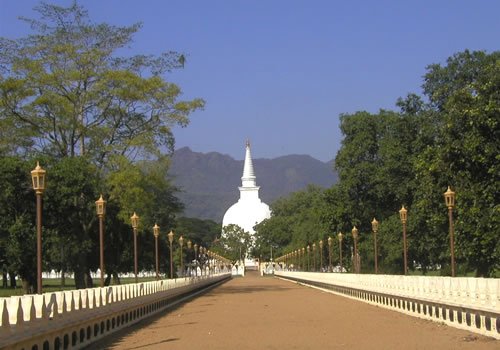Mahiyanganaya
Mahiyanganaya

Things to do at Mahiyanganaya:
Mahiyangana Stupa
The ancient Mahiyangana Stupa is one of the sixteen most venerated Buddhist Stupas of Sri Lanka. It is believed Buddha’s hair relic is enshrined within the ancient Mahiyangana Stupa. The Stupa was enlarged by the Buddhist monk Arahat Sarabhu to a height of 12 cubits after receiving and enshrining the collar bone relic of the Buddha taken from the funeral pyre. Thus Mahiyangana became the first ever Stupa to be built in Sri Lanka. The great king raised the chethiya to a height of 80 cubits. It was only after the reconstruction of the Mahiyangana Stupa, King Dutugmunu carried on his military campaign to save the island nation from the Dravidian invaders.
Sri Lanka’s greatest historical chronicle, Mahawamsa reveals that nine monks since the supreme enlightenment of Buddha, having foreseen that the island of Sri Lanka is destined to have the Buddhism established and remain so for 5000 years, visited the island to preach the doctrine to the pre-historic inhabitants belonging to the tribes of Yaksha, Naga and deva.
Dambana and Sri Lanka’s Aborigines ( Vedda community)
Dambana located 19km north east of Mahiyangana bordering the Maduru Oya Sanctuary is home to the indigenous “Vedda” community numbering close to 1000 individuals. Sri Lanka’s Aborigines’, or the Veddha’s meaning “people of the forest” of Sri Lanka has a history much older than prince Vijaya’s landing in 5th century BC and the origins of the Sinhala race. The natural habitat of these people, whose livelihood once depended solely on hunting, was confined to the forest. They are essentially hunter gatherer forest dwellers without much change in their life style from Stone Age to modern times. Veddha’s also collect bee’s honey and exchange it with the locals for axe hanging from their shoulders and a bow slung behind them.
The total extinction of their traditions of hunting for food, cooking in open fire with a group, collecting Bees Honey, their songs and dances has now become a rare possibility. Today, the Veddha’s are more modernized as far as at least the cloths are concerned and perfect way to observe Veddha is to organise a camp close to or within a reservation However during the recent decades, they have been shifting in a slow transformation into Chena dry land for cultivation.
A ideal place to observe Veddha is their last remaining village of Dambana. Veddha’s will be more than happy to show you their ways of life, with an axe hanging from their shoulders and a bow slung behind them, gives you the feeling nothing much has changed since the dawn of time for these proud warriors of the jungle.
Mahiyanganaya situated close to the Mahaweli River in Badulla district. It is said that Lord Buddha visited Mahiyanganaya on the full moon Poya day of January in order to settle a dispute arose between Yakkas and Nagas (two tribes then inhabited this area). It was his first ever visit to Sri Lanka. Mahiyangana is a Pali word (in Sinhalese Bintenna) which means flat land.
Sorabora Wewa Reservoir
The famous Sorabora Wewa (tank), the massive irrigation reservoir of ancient Bintanne. The Sorabora Tank is built damming the Diyawanna Oya with a 1590 feet (485 meter) embankment. The scenic Sorabora Wewa tank bordering the Veddah settlements at Dambana is an ancient irrigation reservoir of remarkable expanse, constructed during the time of King Dutugemunu (161–137 BC), the hero of the nation. According to the legend, the tank was said to be built by a villager called Bulata.
The sluice which has been intact and in use since, was built on a natural existing granite rock. Sorabora Wewa which was called the Sea of Binthanne in the ancient past is unique to all other ancient reservoirs a is considered the only existing reservoir which does not make use of a Bisokotuwa, the heart of all other large reservoirs of the country. This ground breaking invention was the single factor which enabled the ancients to build massive reservoirs since 4th century BC.
This tank is magnificently shaped between two natural stone sluice gates and these gates reveal evidence for how marvelous the engineering skills of our forefathers were. Generally all the reservoirs have the sluice gates which regulate the water flow out of the reservoir on the massive embankments. It was the Bisokotuwa which regulated the water pressure at the sluice gates inside the tank and protected the embankment from erosion. Today the Sorabora Wewa Reservoir which is rich in birdlife is magnetism to the nature lovers.
